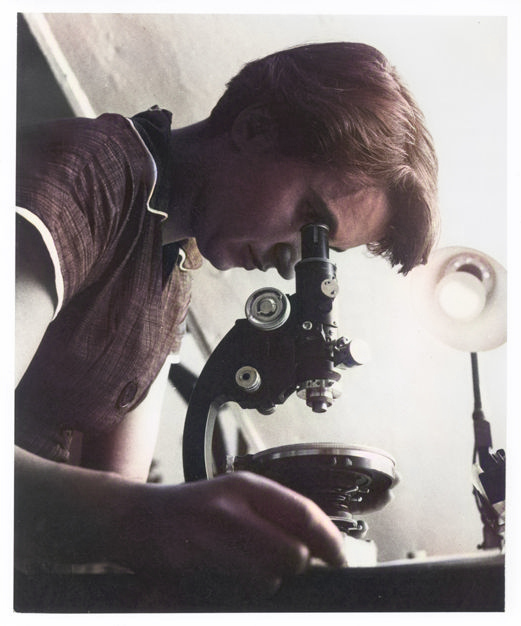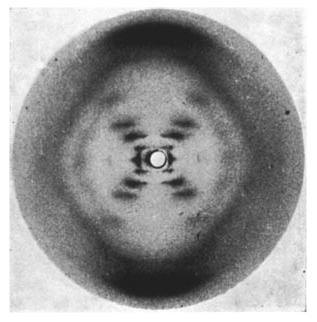
Rosalind Elsie Franklin (25 July 1920 – 16 April 1958)
On July 25, 1920, British biophysicist and X-ray crystallographer Rosalind Elsie Franklin was born. She made the first clear X-ray images of DNA’s structure. Her work was described as the most beautiful X-ray photographs ever taken. Franklin’s ‘Photo 51’ informed Crick and Watson [5] of DNA’s double helix structure for which they were awarded a Nobel Prize.
Rosalind Franklin – Early Years
Rosalind Franklin was born in Notting Hill, London, as the second of five children into an affluent and influential British Jewish family. From early childhood, Franklin showed exceptional scholastic abilities. She was educated at St Paul’s Girls’ School where she excelled in science, Latin and sports. From the age of 15 on, she knew already that she wanted to become a scientist. Rosalind Franklin enrolled at Newnham College, Cambridge, in 1938 and studied chemistry. In 1941, she was awarded Second Class Honors in her finals, which, at that time, was accepted as a bachelor’s degree in the qualifications for employment. When she graduated, Franklin was awarded a research scholarship to do graduate work. She spent a year in R.G.W. Norrish’s lab without great success. Norrish recognized Franklin’s potential but he was not very encouraging or supportive toward his female student. Rosalind Franklin studied during a time when a woman’s academic education was by no means a matter of course. Female scientists found it very difficult to gain recognition, especially in the natural sciences. It was not until 1945 that the first women scientists were accepted into the British Royal Society. 1944 was the year in which Otto Hahn was awarded the Nobel Prize, but Lise Meitner was passed over,[7] as in the following years. She went on to work as an assistant research officer at the British Coal Utilisation Research Association(CURA), where she studied the porosity of coal — work that was the basis of her 1945 Ph.D. thesis “The physical chemistry of solid organic colloids with special reference to coal.” [1] CURA was a young organization and there was less formality on the way research had to be done. Franklin worked fairly independently, a situation that suited her. Franklin worked for CURA until 1947 and published a number of papers on the physical structure of coal.
Paris Years
Franklin’s next career move took her to Paris from 1947 to 1950. An old friend introduced her to Marcel Mathieu who directed most of the research in France. He was impressed with Franklin’s work and offered her a job as a “chercheur” in the Laboratoire Central des Services Chimiques de l’Etat. Here she learned X-ray diffraction techniques from Jacques Mering. She has documented her work in numerous essays published in journals such as Acta Crystallographica or the Transactions of the Faraday Society. At the end of her years in Paris, she was an internationally recognized scientist in her field.
Kings College and Maurice Wilkins
In 1951, Franklin was offered a 3-year research scholarship at King’s College in London. With her knowledge, Franklin was to set up and improve the X-ray crystallography unit at King’s College. Maurice Wilkins [6] was already using X-ray crystallography to try to solve the DNA problem at King’s College. Franklin arrived while Wilkins was away and on his return, Wilkins assumed that she was hired to be his assistant and not a colleague largely equal to him.. It was a bad start to a relationship that never got any better. [2]Wilkins‘ mistake, acknowledged but never overcome, was not surprising given the climate for women at the university then. Only males were allowed in the university dining rooms, and after hours Franklin’s colleagues went to men-only pubs. But Franklin persisted on the DNA project.
Research on DNA
The scientists at King’s College had a particularly pure DNA sample at their disposal, the consistency of which was reminiscent of turnip greens. A glass rod was used to extract a barely perceptible fibre of DNA. When water was extracted from this fibre, its structure showed orderly, repetitive, quasi-crystalline properties. Rosalind Franklin developed methods of adding water to A-form DNA. With the help of her X-ray diagrams, Franklin was able to show that the structure of the DNA had changed after the water was removed. Franklin found out that DNA molecules occur in two forms, A and B, which differ in their water content. She developed a process to obtain the two forms in their pure form, and thus succeeded in obtaining x-rays of the highest quality. Her images were the best images of DNA ever obtained. J. D. Bernal called her X-ray photographs of DNA, “the most beautiful X-ray photographs of any substance ever taken.“
The Structure of the DNA
The decoding of DNA and the discovery of the double helix were “in the air” in the early 1950s. At the end of the 1940s, it had been proven that DNA consisted of long unbranched chain molecules. Between 1951 and 1953 Rosalind Franklin came very close to solving the DNA structure. She was beaten to publication by Crick and Watson in part because of the friction between Wilkins and herself. Two young scientists at the University of Cambridge, James Watson and Francis Crick – the latter had not even completed his doctorate at the time – who were still unknown at the time, saw this field as an opportunity to acquire scientific fame. They knew, however, that they would have to come up with results very quickly and that a quick publication would be necessary if they were to pre-empt a breakthrough by Linus Pauling.[9] Both were in close contact with Maurice Wilkins of King’s College.

X-ray diffraction image of the double helix structure of the DNA molecule, taken 1952 by Raymond Gosling, commonly referred to as “Photo 51”, during his work with Rosalind Franklin on the structure of DNA
Deciphering the Double Helix
While Franklin preferred an empirical approach, the strength of Crick and Watson lay in developing theories. Using the information they had gained from a lecture by Franklin at King’s College, Crick and Watson had developed a model in 1952 that consisted of three spiral chains. They therefore invited Franklin and Wilkins to Cambridge in late 1952 to present their model of DNA to them. For Franklin, the trip was a waste of time; she proved to her colleagues that her model was completely inadequate and left Cambridge again in a huff. She also refused to cooperate with these colleagues because she thought it was too early to set up a model. On 30 January 1953 Wilkins, without permission, granted Watson and Crick access to Franklin’s diffraction image No. 51 with a B-configuration of DNA, which was the optical proof, particularly for Watson, that DNA was a helix. While Wilkins and Franklin did not want to propose a detailed structural model based on this recording, for Watson this was one of the crucial moments in deciphering the DNA. The results went into an article in Nature almost immediately. Franklin’s work did appear as a supporting article in the same issue of the journal.[3]
The Debate Continues
A debate about the amount of credit due to Franklin continues. What is clear is that she did have a meaningful role in learning the structure of DNA and that she was a scientist of the first rank. Franklin moved to J. D. Bernal’s lab at Birkbeck College, where she did very fruitful work on the tobacco mosaic virus. She also began work on the polio virus. In the summer of 1956, Rosalind Franklin became ill with cancer. She died less than two years later.Franklin was never nominated for a Nobel Prize. She had died in 1958 and was therefore ineligible for nomination to the Nobel Prize in 1962 which was subsequently awarded to Crick, Watson, and Wilkins in that year. The award was for their body of work on nucleic acids and not exclusively for the discovery of the structure of DNA. Watson has suggested that ideally Wilkins and Franklin would have been awarded the Nobel Prize in Chemistry.
“Rosalind Franklin and DNA”, by Brian Sutton, [13]
References and Further Reading:
- [1] Rosalind Franklin at biographies.com
- [2] Rosalind Elsie Franklin at DNA Research Center
- [3] Rosalind Elsie Franklin – Pioneer Molecular Biologist
- [4] Rosalind Franklin at Famous Scientists
- [5] How Crick and Watson deciphered the DNA, SciHi Blog
- [6] Maurice Wilkins and the Riddle of the DNA Structure, SciHi Blog
- [7] Lise Meitner – The Misjudged Genius, SciHi Blog
- [8] Linus Pauling – From Quantum Chemistry to Molecular Biology, SciHi blog
- [9] Denis Grady: A Revolution at 50; 50 Years Later, Rosalind Franklin’s X-Ray Fuels Debate New York Times, 25. Februar 2003
- [10] “Rosalind Franklin publications”. Garfield Library. University of Pennsylvania.
- [11] Piper, Anne (April 1998). “Light on a dark lady”. Trends in Biochemical Sciences. 23 (4): 151–154
- [12] Rosaling Franklin at Wikidata
- [13] “Rosalind Franklin and DNA”, by Brian Sutton, American Crystallographic Association @ youtube
- [14] Timeline of Crystallographers, via Wikidata and DBpedia






Pingback: Whewell’s Gazette: Year 03, Vol. #50 | Whewell's Ghost
Hi there, there is an error on the graphic sketch describing DNA X-ray cristallography: The source was an X-ray tube, but on your picture it says “laser”. Although there are also X-ray laser devices nowadays (like synchrotron radiation sources), but Franklin and co. used a classic high-voltage hot cathode tube.
Thank you very much for spotting this mistake. We have substituted the picture with a copy of “photo 51”.